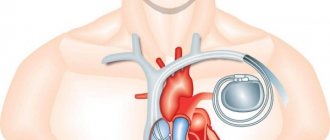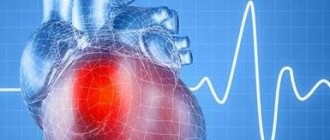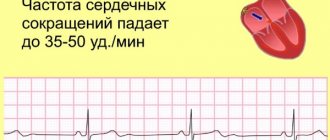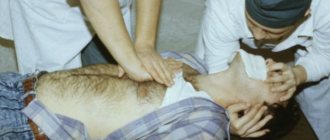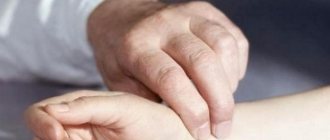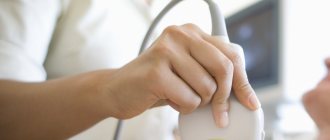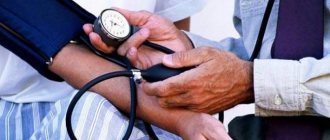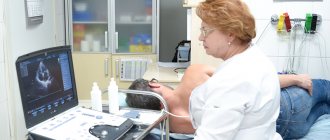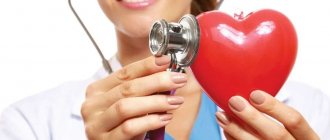Causes of sinus arrhythmia
Physiological sinus arrhythmia is very common in healthy people. The human heart is sensitive to changes in the functioning of the body and signals from the nervous system. So, during physical activity, the heart rate increases, and during rest it returns to the usual 60 - 80 beats per minute.
The breathing phase also affects the heart rate. On inhalation they become less frequent, on exhalation they become more frequent. Such increases and decreases, in principle, can be characterized as physiological sinus arrhythmia. In children and adolescents, sometimes there is another variant: unequal time intervals between “adjacent” heart contractions. This is a manifestation of the immaturity of the nervous system. As you grow older, it goes away on its own. In addition, athletes and people in good physical condition may have a heart rate less than 60 beats per minute. This phenomenon is called physiological bradycardia, and it can also be called a type of “normal” sinus arrhythmia.
Pathological sinus arrhythmia occurs as a consequence of diseases, including:
- Obstructive sleep apnea syndrome
- Heart diseases
- Nervous system dysfunction (neuroses, vegetative-vascular dystonia)
- Endocrine diseases (thyroid dysfunction, diabetes mellitus)
- Diseases of the respiratory system (bronchial asthma)
- Intoxications (medicines, alcohol)
- Electrolyte disturbances.
Sometimes the cause of sinus arrhythmia cannot be identified.
What needs to be examined
Diagnosis is carried out under the supervision of a cardiologist.
This is his prerogative. As needed, specialists in endocrinology and the nervous system are involved. An approximate list of activities is as follows:
- Interview of the patient orally with recording of complaints.
- Daily monitoring. Allows you to evaluate both indicators (BP and heart rate), at rest and within the framework of usual physical activity. This is an informative technique.
- Electrocardiography. The most important study. It is carried out both at rest and after activity (so-called stress tests). Typically, a treadmill and bicycle ergometry are used.
- Angiography.
- CT or MRI of the heart.
- Echocardiography. Ultrasound technique.
- Blood tests (biochemistry, hormones and general).
At the discretion of specialists, other diagnostic methods are also used. As a rule, these are enough and even many.
Symptoms and complications of sinus arrhythmia
Physiological arrhythmia usually does not cause any discomfort or consequences.
Pathological sinus arrhythmia can manifest itself in different ways. It most often occurs in three forms: sinus bradycardia, sinus tachycardia and extrasystole.
Sinus bradycardia is characterized by a heart rate below 60 beats per minute at rest. Patients with bradycardia complain of attacks of weakness, dizziness, and pain in the heart area. Periodically they experience fainting. These symptoms can be observed either all together or separately - each patient has individual manifestations. Sinus bradycardia often occurs at night in obstructive sleep apnea syndrome. Against the background of respiratory arrests, the body reflexively seeks to conserve oxygen reserves, and heart activity slows down.
Rare heartbeats lead to the fact that an insufficient amount of blood reaches the organs and tissues, they lack oxygen and nutrients, and this negatively affects their vital functions. Frequent complications of sinus bradycardia include strokes, heart failure, and myocardial infarction. This condition can even cause cardiac arrest (called sudden cardiac death).
Sinus tachycardia is an increase in heart rate, usually up to 120, sometimes up to 150 beats per minute. Its signs are a feeling of rapid heartbeat, squeezing pain in the chest (sometimes), attacks of weakness and dizziness, and loss of consciousness. With sinus tachycardia, the heart fills with less blood than necessary. Blood pressure decreases. The organs (primarily the heart muscle itself) are insufficiently supplied with blood. Sinus tachycardia is often complicated by the development of myocardial infarction and heart failure.
Pathological sinus extrasystole usually manifests itself as a feeling of a sinking heart followed by a strong shock in the chest, or attacks of increased heartbeat. They may be accompanied by pain in the heart area, pale skin, a feeling of anxiety, and lack of air.
Sometimes all these violations are not felt by a person at all.
Case study: a young man with connective tissue dysplasia
I would like to present an unusual case of sinus arrhythmia.
A young man, 24 years old, approached me. Recently, he began to experience discomfort in the heart area and began to experience slight dizziness. The patient does not smoke, does not drink alcohol, and does not take any medications. Body temperature is normal. When I began to measure his pulse, it turned out to be irregular. During a general examination, I noticed that the young man had signs of connective tissue dysplasia - thinness, tall stature, hypermobility of the joints (wrist, elbow, knee). Decoding of the cardiogram - sinus arrhythmia. When holding the breath, the rhythm disturbance persisted. An echocardiogram revealed mitral valve prolapse, which is another criterion for connective tissue dysplasia. A blood test showed a low magnesium concentration. I prescribed Magne B6 and recommended including foods rich in this microelement (buckwheat, bananas, nuts, oatmeal) in the diet. Upon re-appointment, the patient noted a significant improvement in his condition. Manifestations of arrhythmia completely stopped. The cardiogram and magnesium levels returned to normal.
Treatment of sinus arrhythmia
Physiological sinus arrhythmia does not require treatment.
To get rid of pathological sinus arrhythmia, you need to cure the disease from which it is a consequence. Arrhythmia is quite often a symptom of obstructive sleep apnea.
Make an appointment with a somnologist if, in addition to arrhythmia, you have any of the following symptoms:
- Stopping breathing during sleep;
- Snore;
- Restless, unrefreshing sleep;
- Daytime sleepiness, fatigue;
- Excess weight;
- Nighttime suffocation, coughing or waking up from lack of air;
- Morning headache;
- Urinating more than once at night;
- High blood pressure;
- Night sweats;
- Diagnosed diseases of the cardiovascular system (coronary heart disease, heart failure, rhythm disturbances), diabetes mellitus.
If the results of overnight polysomnography reveal that a patient has moderate or severe obstructive sleep apnea, CPAP therapy will effectively help him. This is a hardware treatment method that, from the first night of treatment, eliminates snoring, sleep apnea and heart rhythm disturbances caused by apnea.
For sinus tachycardia, treatment is predominantly medicinal and aimed at reducing the heart rate. For this purpose, sedatives (motherwort, valerian), beta-blockers, etc. are used.
Treatment of sinus bradycardia is aimed at increasing the heart rate. For this purpose, both medications (sympathomimetics, anticholinergics) and implantation of an electrical pacemaker are used for severe bradycardia that threatens the patient’s life.
Sinus extrasystole is treated with antiarrhythmic drugs.
Slow heartbeat - bradycardia
Bradycardia is a condition where the heart beats so slowly that it cannot pump enough blood to meet the body's needs. If bradycardia is left untreated, it can lead to extreme fatigue, dizziness, or fainting because not enough blood is supplied to the brain. This condition can be corrected by using an electronic pacemaker, which makes the heart beat normally.
Bradycardia occurs for various reasons:
- Sick sinus syndrome
The appearance of sinus bradycardia as a result of a “malfunction” in the sinus node (the natural pacemaker of the heart) occurs when discharges for contractions occur too infrequently. A weak sinus node can develop with age or be a consequence of illness. Some medications may also cause or worsen bradycardia. This arrhythmia may be temporary or permanent. It can be treated with medications or an electronic pacemaker.
- Blockage of the heart pathways
Heart block is a slowing or interruption of the electrical signal to the lower chambers of the heart (ventricles) that cause the heart muscle to contract. The heart's electrical conduction system typically sends signals from the upper chambers of the heart (atria) to the lower chambers (ventricles), which causes coordinated contractions of the heart muscle. Complete blockade of the atrioventricular node can manifest as a sudden loss of consciousness, since the ventricles contract very rarely without stimulus from the sinus node. An artificial pacemaker can eliminate this problem and normalize heart function.
Prevention of sinus arrhythmia
A healthy lifestyle helps prevent the development of various heart rhythm disorders, including sinus arrhythmia. A properly selected diet with a limit on sweets and fatty foods, simple exercise or walking are quite effective means of preventing sinus arrhythmia.
Giving up bad habits is of great importance. The list of diseases caused by drinking alcohol and smoking is far from exhausted by arrhythmias.
To fully prevent sinus arrhythmia, healthy sleep is necessary - sound and of sufficient duration. Various sleep disorders, primarily sleep apnea syndrome, can provoke heart rhythm disturbances. Consulting a somnologist will help solve sleep problems. Typically, these specialists conduct appointments at sleep centers. The leading Russian Center for Sleep Medicine operates on the basis of the Rehabilitation Clinic in Khamovniki at the address: Moscow, st. Efremova, 12с2.
Snoring, apnea, insomnia or other problems? Contact the Sleep Medicine Center at the Rehabilitation Clinic in Khamovniki. We will definitely help you! Ask questions and sign up for a consultation by phone.
Forecast
Cardiac arrhythmias are dangerous because they can lead to sudden cardiac arrest due to complete blockade of conduction. In severe arrhythmia, there is a high risk of ventricular fibrillation, which can be fatal. Atrial fibrillation leads to the formation of blood clots in the atria and their transfer to other organs with the development of stroke and gangrene of the extremities. The probability of an unfavorable outcome in patients with arrhythmias depends on the form of rhythm disturbance and is more than 20% per year. You should not rely on folk remedies - arrhythmia is very dangerous and requires correction by a professional cardiologist.
Diet for respiratory arrhythmia
The diet should be balanced and varied, with a predominance of raw fruits and vegetables, herbs, dairy products, and fish. It is necessary to limit the consumption of sweet, starchy and too fatty foods, as well as products containing caffeine. Also useful are walks, trips to nature, and engaging in any hobby that will fill the patient’s life with positive emotions and help avoid stress.
What foods are most useful for heart rhythm disorders? Watermelon and melon remove excess cholesterol. Turnips are great for calming heart palpitations. Grapes eliminate swelling and shortness of breath, improve the tone of the heart muscle. Apples reduce the risk of developing tumors, normalize blood pressure, and improve digestion.
Avocado contains enzymes that help the body absorb substances necessary for the correct functioning of the heart. Potatoes and cabbage are sources of potassium, which normalize the functions of the heart muscle. Cereals effectively inhibit the absorption of cholesterol. Pumpkin corrects the water-salt balance and helps reduce blood pressure.
If a person who has been diagnosed with respiratory arrhythmia eats right, devotes time to moderate physical activity and avoids stress, then he will not feel any discomfort.
Diagnostics
The main method for diagnosing arrhythmia is electrocardiography, which can be recorded once or throughout the day (Holter monitoring).
In case of arrhythmia, the ECG must have a P wave, indicating that the source of contraction is the sinus node. The heart rate is usually increased or decreased. To exclude the influence of the respiratory cycle on the ECG results, during the manipulation the patient is asked to hold his breath at the height of inspiration.
To exclude organic pathologies of the heart, ECHO-CG is performed. Using ultrasound, you can determine the condition of various structures and measure the dimensions of the chambers. An invasive electrophysiological study involves stimulating or inhibiting the sinus node and assessing its response. It is not performed often and only according to strict indications.
Normal ECG findings in athletes: recognizing physiological adaptations
A large international team of experts presented an article - one of a number of detailed methodological explanations of the practice of applying the so-called “Seattle Criterion”. The criterion is intended to facilitate the task of early diagnosis of cardiovascular system disorders in athletes using a 12-channel electrocardiograph.
The work is devoted to those unusual signs that in an ordinary person may indicate the development of conditions leading to a sudden heart attack, but in the case of athletes they only reflect the normal adaptive processes that occur in the body under the influence of regular physical activity. The authors hope that taking these processes into account will avoid many additional pointless studies of athletes and unjustified restrictions on the training and competitive processes.
Up to 60% of athletes demonstrate such changes on cardiograms (individually or combined) as:
- sinus bradycardia
How is cardiac arrhythmia treated?
There are several methods for treating arrhythmia:
- drug therapy. The patient can be prescribed both drugs that have antiarrhythmic properties and drugs that do not directly affect the electrophysiological properties of the myocardium. The latter are called upstream therapy. It includes ACE inhibitors, angiotensin II receptor antagonists, statins, corticosteroids, polyunsaturated fatty acids and other drugs. Upstream therapy is aimed at eliminating the causes that lead to arrhythmia: inflammatory processes, high blood pressure, myocardial remodeling;
- implantation of a pacemaker - a medical device that affects the heart rhythm. Most often, a pacemaker is used for slow heart rate and AV block;
- radiofrequency ablation of the heart (RFA) is a surgical intervention during which an electrode is used to destroy the focus of pathological excitation of the myocardium or areas of abnormal impulse conduction.
Moderate sinus arrhythmia in a child
Moderate sinus arrhythmia in a child is not dangerous if its cause is immaturity of nervous regulation, as is the case with respiratory arrhythmia. However, even trained children may experience seemingly causeless sinus arrhythmia, and in this case, a visit to a cardiologist is mandatory. Each case of arrhythmia in a child must be subjected to observation and strict control, because if sinus arrhythmia occurs without an obvious reason, especially if the child makes complaints, which will be discussed below, a comprehensive examination of the body is necessary.
Regular observation by a cardiologist is the key to timely diagnosis of the transition of a moderate arrhythmia in a child into something more serious. Often respiratory arrhythmia is detected during a routine examination, but sometimes the child makes specific complaints. If the child’s age is too young for him to be able to formulate a complaint about poor health or pain, sufficiently observant parents themselves can notice changes in the child’s behavior if they look closely at the baby. When the heart stops working, the child may experience cyanosis (blue discoloration) or pale skin.
This is also accompanied by shortness of breath, which may manifest itself at a younger age as intermittent, “choking” crying. Such cases of arrhythmia can appear at any time of the day, and therefore the child is characterized not only by anxiety during the day, but also by sleep disturbance at night. The baby loses his appetite or continues to eat, but with great reluctance. Also, if you look closely, in some cases you can see the pulsation of large vessels. Older children may lose consciousness when a cardiac arrhythmia occurs or complain of dizziness. Also at this moment, the pressure may decrease, and some children feel the heart skip a beat or, conversely, make a strong push.
Of course, each of the listed complaints in itself seems to be a reason for a visit to the doctor, and if there is a combination of several of them, most likely the child suffers from something more serious than mild sinus arrhythmia. First of all, after the examination, the child will be sent for electrocardiography, and then two scenarios are possible: the baby can continue to be monitored on an outpatient basis or be sent to hospitalization. In case of hospitalization, tests include a clinical blood and urine test, an ultrasound examination of the heart, an echocardiogram, and a chest x-ray. In general, each diagnostic case is individual, and further tactics are determined by the attending physician.
How does arrhythmia manifest?
Arrhythmia may be accompanied by the following symptoms:
- a feeling of interruptions in the work of the heart;
- a feeling of somersault, a jolt in the heart;
- accelerated heartbeat;
- suffocation;
- dizziness;
- general weakness, fatigue;
- exercise intolerance.
The most severe manifestations of arrhythmia are presyncope and loss of consciousness, which are most often associated with a very high heart rate (more than 200 beats/min).
In addition, there are “silent” arrhythmias that are asymptomatic. They are usually diagnosed by electrocardiography.
